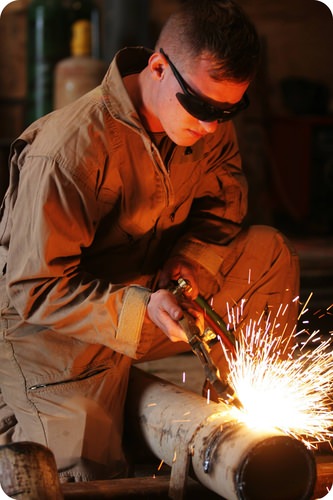17.16 赫斯的《热相加法》
章节大纲
-
How much energy is involved in the operation of an acetylene torch?
::乙炔火炬的操作涉及多少能源?Since there is a complex series of reactions taking place, simple methods for determining the will not work. We need to develop new approaches to these calculations.
::由于正在发生一系列复杂的反应,确定意愿的简单方法行不通,我们需要制定新的计算方法。Adding Heats of Reaction
::添加反应热量It is sometimes very difficult or even impossible to measure the change for a reaction directly in the laboratory. Some reactions take place extremely slowly, making a direct measurement unfeasible. In other cases, a given reaction may be an intermediate step in a series of reactions. Some reactions may be difficult to isolate because multiple side reactions may occur at the same time. Fortunately, it is possible to measure the enthalpy change for a reaction by an indirect method. Hess’s law of heat summation states that if two or more thermochemical equations can be added together to give a final equation, then the heats of reaction can also be added to give a heat of reaction for the final equation.
::有时很难甚至不可能测量实验室直接反应的变化。有些反应非常缓慢,使得直接测量变得不可行。在另一些情况下,特定反应可能是一系列反应中的一个中间步骤。有些反应可能很难分离,因为同时可能会发生多个侧面反应。幸运的是,可以测量间接反应的变化。 Hes的热总和法则指出,如果可以将两个或两个以上的热化学方程式加在一起来给出最后的方程,那么反应的热量也可以添加来给最终方程带来热反应。An example will illustrate how Hess’s law can be used. Acetylene (C 2 H 2 ) is a that burns at an extremely high temperature (3300°C) and is used in welding (pictured in the opening image). On paper, acetylene gas can be produced by the reaction of solid carbon (graphite) with hydrogen gas.
::举一个例子可以说明赫斯法律是如何使用的。 乙炔(C2H2)是在极高的温度下燃烧的(3300°C ) , 并被用于焊接(在开端图像中描绘 ) 。 在纸面上,乙炔气可以通过固碳(石墨)与氢气的反应产生。
::2C(s, 石墨) +H2(g) +C2H2(g) H=?Unfortunately, this reaction would be virtually impossible to perform in the laboratory because carbon would react with hydrogen to form many different products simultaneously. There is no way to create conditions under which only acetylene would be produced.
::不幸的是,这种反应几乎不可能在实验室发挥作用,因为碳会与氢同时形成许多不同的产品。 没有办法创造只生产乙炔的条件。However, enthalpy changes for combustion reactions are relatively easy to measure. The heats of combustion for carbon, hydrogen, and acetylene are shown below along with each balanced equation .
::然而,燃烧反应的变化比较容易测量,碳、氢和乙炔的燃烧热与每个平衡方程式一起列示如下。-
::C(s, 石墨) +O2(g) CO2(g) H393.5 kJ -
::H2(g)+12O2(g)+H2O(l)+H285.8千焦耳 -
::C2H2(g)+52O2(g)+52O2(g)+2CO2(g)+H2O(l)H1301.1 kJ
To use Hess’s law, we need to determine how the three equations above can be manipulated so that they can be added together to result in the desired equation (the formation of acetylene from carbon and hydrogen).
::要使用赫斯定律, 我们需要确定上述三个方程式如何被操纵, 才能将它们加在一起, 从而形成理想的方程式( 碳和氢的乙炔形成 ) 。In order to do this, we will go through the desired equation, one substance at a time – choosing the from the equations numbered 1-3 above that contains that substance. It may be necessary to either reverse a combustion reaction or multiply it by some factor in order to make it “fit” to the desired equation. The first reactant is carbon and the in the equation for the desired reaction, the coefficient of the carbon is a 2. So, we will write the first combustion reaction, doubling all of the coefficients and the .
::为了做到这一点,我们将通过理想的方程,一个物质一次选择包含该物质的1-3号方程。 也许有必要将燃烧反应反转或乘以某种因素,以使它“适合”理想的方程。 第一个反应器是碳,而理想反应方程中的碳系数是2。 因此,我们将写出第一次燃烧反应,将所有系数和“H”值翻一番。
::2C(s, 石墨) +2O2(g) 2CO2(g) H=2(- 393.5) 787.0 kJThe second reactant is hydrogen and its coefficient is a 1, as it is in the second combustion reaction. Therefore, that reaction will be used as written.
::第二个反应剂是氢,其系数是1,如同在第二次燃烧反应中一样。因此,该反应将按书面形式使用。
::H2(g)+12O2(g)+H2O(l)+H285.8千焦耳The product of the reaction is C 2 H 2 and its coefficient is also a 1. In combustion reaction #3, the acetylene is a reactant. Therefore, we will reverse reaction 3, changing the sign of the .
::反应的产物是C2H2,其系数也是1。在燃烧反应3中,乙炔是一种反应剂。因此,我们将反转反应3,改变“H”的标志。
::2CO2(g) +H2O(l) C2H2(g) +52O2(g) H=1301.1 kJNow, these three reactions can be summed together. Any substance that appears in equal quantities as a reactant in one equation and a product in another equation cancels out algebraically. The values for the enthalpy changes are likewise added.
::现在,这三种反应可以相加。任何物质,只要在一个方程式和另一个方程式的产品中作为反应器以同等数量出现,就取消代数。正方程式变化的值也随之添加。
::2C(s, 石墨) +2O2(g) +2O2(g) 2(g) H 787. kJH2(g) +12O2(g) H2O(l) 285. 8 kJ2CO2(g) +H2O(l) C2H2(g) +52O2(g) H=1301.1 kJ2C(s,石墨) +H2(g) C2H2(g) H=228.3 kJSo the heat of reaction for the combination of carbon with hydrogen to produce acetylene is 228.3 kJ. When one mole of acetylene is produced, 228.3 kJ of are absorbed, making the reaction endothermic .
::因此碳与氢结合产生乙炔的反应热为228.3千焦耳。当产生一粒乙炔时,228.3千焦耳被吸收,产生反应端热。Summary
::摘要-
Hess’ Law is used to calculate the heat of reaction for processes that cannot be measured directly.
::Hes Law 用来计算无法直接测量的过程的反应热量。
Review
::回顾-
List two reasons direct measurement of a heat of reaction may not be feasible.
::列举两个理由,说明直接测量反应热可能不可行。 -
State Hess’ law.
::州议会法律。 -
If a combustion reaction is reversed, what needs to happen to the
value?
::如果燃烧反应被逆转, 需要发生什么 与"H"值?
-
